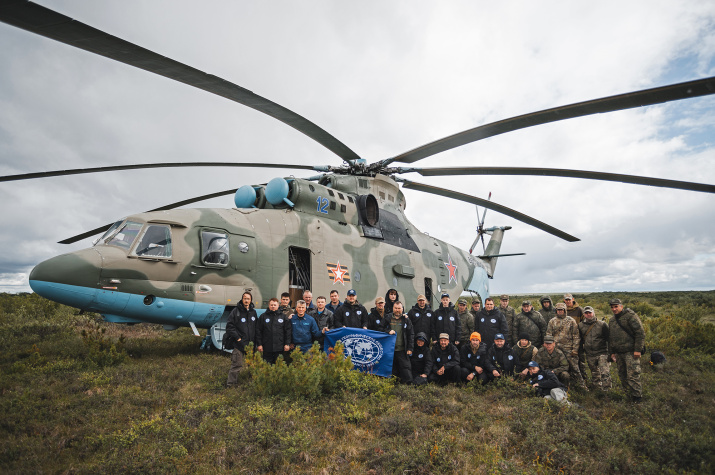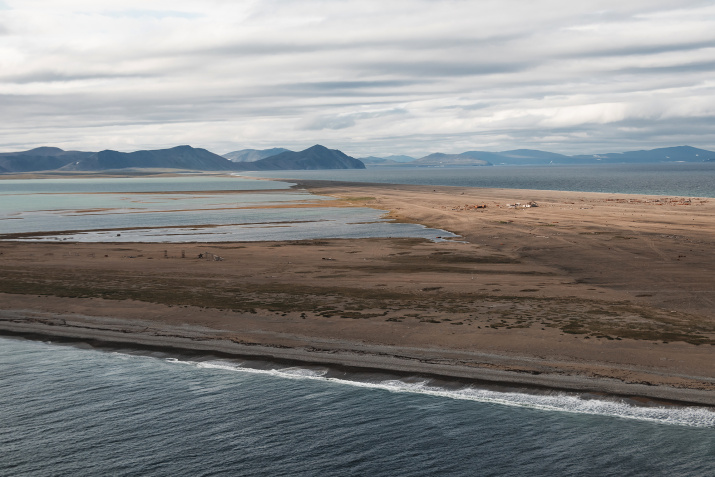The ALSIB expedition discoveries continue. Among the wartime artifacts, there are quite unexpected ones: a garage roof made of American fuel barrels, mixed wreckage of aircraft from different years, and an American grader that is still in use.
An airport building from 1942 still remains in Markovo. Its condition leaves much to be desired: the windows are smashed, the floors are partially dismantled, the doors are wide open, the walls are crooked. Back in the late 1990s, people still worked there, but every May-June the airfield is flooded with water, which sometimes rises five meters, or even higher.
"When I looked through the archival materials, I found that the projects for Khandyga and Olekminsk are identical to the building in Markovo. The original building was made of round timber without facing, the third floor was built up in the center. Later on, it was covered with wood shingles, limewashed, and painted white. The architraves and décor were blue. The village has an active community that stands up for the preservation of this building – the only surviving witness of the ALSIB's operation in the village since the war. It is proposed to either renovate or dismantle it, and build a new one on the old foundation as a museum-club."
Pavel Filin, Candidate of Historical Sciences, participant of the expedition
Over the past 30 years, the forest-tundra has significantly moved north – if during the war years the airport was built on treeless expanses, now willows up to 20 meters high grow throughout the territory. It is not easy to restore historical realities in such conditions – aerial photography does not allow you to see what is hiding under the lush vegetation. Nevertheless, the members of the expedition were able to accurately figure out the location of the runway. They also managed to determine the areas of the crash of the A-20 "Boston" and R-39 "Airacobra" planes and to unearth the remains of an unknown plane in the willows between the expedition camp and the village.
“According to the stories of the locals, in the 70s, in the area of the overgrown anabranch Kuyla, the remains of various aircraft were piled up and rolled up using heavy equipment, no one could tell which ones. We unearthed a rather large fragment, most likely a wing, made of corrugated metal. We have been trying, for a long time, to find at least some markings and nameplates. As a result, we’ve found numbers 2 and 8 and a strange nameplate with an inscription written by hand with something like a permanent marker. What kind of plane it is, we do not know for sure, perhaps a transport aircraft of the Li-2 type."
Pavel Filin, Candidate of Historical Sciences, participant of the expedition
In Omolon, four military buildings have survived, and several families still live in them. The village in Chukotka was founded in 1943 – without the ALSIB’s Krasnoyarsk-Uelkal airway it would simply not exist. The runway remained in the same place, but after the war it was expanded and lengthened – it is still in operation. In a garage of the war years, there is a Lend-Lease American “Bradford” lathe in working order; not far from the runway, an American “Caterpillar” grader, which airport workers use to clear snow.
"The grader is almost in perfect condition. The inscription ‘US Caterpillar’ has been preserved, each part is numbered – a unique technical object, and it still works. The lathe also works to this day. It is interesting, that the nameplates are in both Russian and English, and values are given in inches and millimeters, that is, this device was specially adapted for delivery to the USSR.
The roof of the garage is absolutely fantastic – it is made of cut-out American barrel lids laid in the form of tiles. They are embossed with stamps and inscriptions "US N", "STC". There are dates – most of the barrels are dated 1943. Where the lids end, sheet metal begins, made from cut and rolled barrels. The result was an excellent profile roofing material – it is, to this day, in excellent condition, almost never repaired. That's really Russian ingenuity."
Pavel Filin, Candidate of Historical Sciences, participant of the expedition
In Seimchan, an old airport building is registered as a regional cultural heritage site. It was handed over to a museum, but how exactly it will be used has not yet been decided. Unique 1940s documents on the construction were found in the airport management building: project designs, plans, geological substantiation, budgets and other materials.
“The construction of the airport began back in 1939, but the peak of construction fell on the period of the Great Patriotic War. The project design was approved on November 4, 1941; it was developed by ‘Kolymproekt’, an office within ‘Dalstroy’, a mega-organization subordinate to the NKVD. The head engineer of the project was Suvorov. We will look for the name and patronymic at the end of the expedition."
Pavel Filin, Candidate of Historical Sciences, participant of the expedition
In Zyryanka, a runway was a spare, it was used mainly by transport aircraft. But on occasion, it also received bombers. In the spring, this unpaved, gravel-sand runway is washed away by the Kolyma River, which spreads widely every flood.
“In February 1943, there was such a case. The group of twelve ‘Airacobras’ I was leading had to land on the frozen sandy spit of the Kolyma River, near the village of Zyryanka: the destination airfield of Seimchan was covered with fog. The temperature was 46 degrees below zero. We had to camp overnight. No heaters. Nevertheless, in the morning the whole group flew away. The departure was facilitated by the flight mechanic of the leader bomber B-25, an experienced polar explorer D. Ostrovenko. All night, under his supervision, the residents of Zyryanka were using wood to stoke the iron stoves installed under the “Airacobras” covered with large tarps, which were offered to us by local fishermen."
From the memoirs of the polar pilot Ilya Mazuruk
Of the wartime aircraft town buildings, only one has survived – a typical barrack located next to the air terminal. Despite the depressing state of the building, people still live in it, waiting to be resettled under the Dilapidated Housing Program.
The expedition completed the exploration of the eastern part of the Krasnoyarsk air route. The specialists participating in it collected archival data, took photographs and filmed videos, mapped the crash sites of the detected aircraft, and clarified information about the dead pilots. The next stage is ahead – exploration of historical airfields in Yakutsk, Olekminsk, Vitim and Kirensk.
The ALSIB – an air corridor connecting the USSR and the USA – was created during the Great Patriotic War. Under the Lend-Lease agreement, the Western Allies supplied us with fighters and bombers, and we needed a year-round and round-the-clock air route along which Soviet pilots could ferry aircraft to the front. Despite the inaccessibility of the areas where the airfields were built, they were erected in the shortest possible time, in just five to eight months. Since 1942, 8,094 aircraft had been delivered to the front along the ALSIB route.
Olga Ladygina


